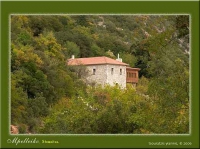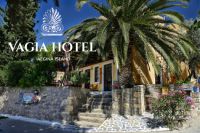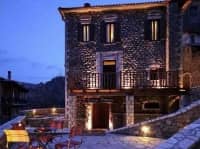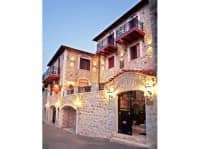Discover Alonissos: Ten Different Suggestions
Alonissos is an island full of features that will make you fall in love and want to visit it again and again. Uniqueness is one of them. It has its own distinct identity, and in every corner it reveals yet another distinctive feature. With calm, high quality tourism, it offers visitors the opportunity to enjoy the peacefulness of nature and the authenticity of local life without unnecessary distractions. Along with another six smaller islands, Alonissos belongs to the National Marine Park of Alonissos and Northern Sporades, which is the first marine park in Greece and the largest protected marine area in Europe (part of the Natura 2000 network).
It is difficult to determine the ten "best" points of interest in a place, and opinions will differ, but at least we can suggest those that made the greatest impression on us.
We counted almost fifty accessible beaches–something for every taste. Each has its own character, but all feature blue-green water, a result of the lush vegetation that covers the whole island.
1. Kokkinokastro
The small peninsula of Kokkinokastro, with a gorgeous beach next to it, is one of the most impressive spots in Alonissos. The reddish soil, the wild rocks and cliffs, and the beautiful blue water that embraces the long sandy beach, with the little island of Kokkinonisi in front of it, make up a natural landscape of unique beauty. At the northeastern end of the small peninsula, excavations have brought to light traces of an ancient settlement. It is difficult to reach the peninsula via the narrow ‘neck' connecting the peninsula to the mainland; access is easier by sea, landing at the small beach in the southeastern part of the peninsula.
2. Climb to the Top of Kalovoulos Mountain
A fairly extensive network of marked paths with a total length of 35 kilometers has been developed in Alonissos. It covers much of the island, except for its northern section, which is more difficult to hike and less accessible. (In the northern section, we have singled out the path from the small port of Gerakas to the cove of Tourkou Mnima, which is not included in the numbered paths, although it is marked.) The abundance of dense vegetation in some parts of the island makes the hiking experience more interesting, but in some places quite adventurous (especially after the snowfall of 2017 brought down many pine trees). Apart from the main paths, there are several other shorter ones that end up in equally exciting spots on the island. These include the path that connects Steni Vala with the beautiful cove of Agios Petros and its idyllic beach, and the paths that lead to the splendid beaches of Spartines.
A detailed discussion of all 16 trails can be found in the Paths of Alonissos article on Exploring Greece.
We especially recommend Path Two (2), which ascends to the top of Kalovoulos Mountain (325 meters altitude) west of Chora (which is also called Hora, Alonissos, and the Old Town).
Covering 180 meters of altitude difference, this is a tiring but enjoyable climb to the top of Kalovoulos Mountain. Path 2 is passable, well-marked, and easy to follow. From Chora, after the settlement’s cemetery, we head toward Mikros Mourtias. At the beginning of the road, we will see a sign on our right that points toward Kalovoulos. The total route is 1,600 meters long, and it takes less than 45 minutes. From the halfway point onward, there is a gorgeous panoramic view of Chora behind us. Once we get to the stone ruins, we follow the red markers to the right for another 100 meters to reach the top (325 meters altitude). There we will also find the typical cement triangulation pillar. A little lower, to our left (to the west), there is a square wooden gazebo (one of many on the island) with a bench, table, and beautiful view looking west toward Skopelos. The best time for the ascent is one hour before sunset.
3. Get to Know the Islands of Peristera and Kyra-Panagia
Alonissos is an ideal base for exploring the sea. In the port of Patitiri, in addition to the tourist excursion boats, there are boats for rent, with or without a driver, so you can plan your own routes and discover the beauty of the sea around Alonissos and the nearby islands. Among the most popular attractions that are accessible only by sea are the blue cave, the islet of Kyra Panagia with the Monastery of the Virgin Mary (a dependency of Mount Athos), and the islet of Peristera (about 5 nautical miles from the port of Patitiri), with several sheltered beaches and a shipwreck you can visit.
4. Sunset at the Church of the Saints Anargyri
Visit the church of the Saints Anargyri (Agii Anargyri) in the southwestern part of the island, with its beautiful view of the bay of Megali Ammos, especially at sunset. In the area around the church, some monastic remains have survived. The monastery here belonged to the monastery of Megisti Lavra of Mount Athos. The earthquake of 1965 destroyed the old church (which has been restored), and a younger one with a red roof was built next to it. We can get to the church of the Saints Anargyri by taking Path Five (5). More specifically, follow the road that heads toward the beach of Tsoukalia, but 1,100 meters before the beach turn right onto the dirt road at the sign for the church. Drive 1,300 meters to the end of the road, where Path Five (5) begins, heading to the church of the Saints Anargyri, Tourkoneri, and Megali Ammos. To reach the church, walk 250 meters down a path through the pine trees. From here the path continues, reaching the first beach in Tourkoneri after 400 meters.
5. Get to Know Chora (the Old Town, Alonissos)
The Old Town, or Palio Chorio, also called Chora, Hora, and Alonissos, was once the main town on the island. Until 1965 it was the island’s capital, but a strong earthquake forced its inhabitants to leave. With most of its homes half destroyed and the town uninhabited, Chora was restored by foreigners (mostly German and British), who loved it and respected its history and culture. They decided to buy the ruins and transform them into a beautiful, lively settlement. Today, 60% of its inhabitants are foreigners. They have opened restaurants, cafés, rooms for rent, and tourist shops in its narrow streets. It is small enough to be easy to explore. Especially noteworthy are the mill, the threshing floors at the edge of town, what remains of the castle, the old churches (such as Saint Dimitrios, the church of Christ, and the churches of Saint Athanasios and Saint George), the Venetian government office building, and the traditional house that is open to the public.
6. Endless Blue at Vithisma Beach
A long, beautiful secluded beach with dark pebbles and sand in the southern part of the island. We can get to it by walking down a 300-meter-long trail that begins 600 meters down the dirt road that starts in the Marpounda region and ends at Megalos Mourtias. The lack of crowds, the endless sea that spreads out in front of us, and a beach long enough to allow privacy are ideal for those who want the tranquility and undisturbed delight of the sun and endless blue. For the above reasons, Vithisma is also known as a nudist beach.
7. A Swim in the Blue-Green Water of Rousoum and a Meal by the Sea
Rousoum Gialos (or Roussoum Yialos) probably got its name from the Turkish word ‘rousoum,’ meaning tax, as the Turks collected taxes here during the time of Ottoman rule. Rousoum is just north of Patitiri (1,000 meters away). Actually, Rousoum and the settlement of Votsi have now been merged with Patitiri. There are several accommodations available near the school and up to the beach, and you will find restaurants and cafés along the beach. Although crowded, the beach is beautiful, with white pebbles and crystal clear blue-green waters that are almost always calm, since the Rousoum Bay forms a fairly safe natural harbor. If you want more isolation, you can dive from the rocks alongside the bay at the point below the last rooms for rent. On the northeastern side of the bay, there is a lush pine forest where it is worth walking.
8. Idyllic Tranquility in the Bay of Agios Petros
To reach the beach of Agios Petros, follow the road that leads to Steni Vala, but turn right onto the dirt road we see one kilometer before the settlement. Proceed for 300 meters, up to the wooden gazebo where Path 10 to Isomata begins. At this point we will see signs on our left indicating a path to the beach of Agios Petros. The passable path goes down 250 meters and ends up at the beautiful, idyllic bay with its lovely sandy beach and crystal clear blue-green water. We can also reach the beach by walking along the coastline, following the stone path that starts at the edge of the Steni Vala harbor and ends 600 meters later at the gorgeous bay.
9. Megali Ammos and Mikri Ammos Beaches
In the bay of Megali Ammos, after Tourkoneri, we will find two very beautiful beaches. The one that is farther south is a small idyllic sandy beach; the other one is the main beach of Megali Ammos. At the first small sandy beach, we were fortunate enough to meet and swim next to a very sweet little Mediterranean seal near the edge of the beach--living proof of the authenticity of the Alonissos Marine Park.
The two beaches are connected by a 500 meter path that moves along the coastline, but above sea level. Although it is called Megali Ammos, which means ‘long sand,’ the longer beach consists mainly of pebbles; even so, it is really worth visiting for a swim in its blue-green water.
10. A Visit to the Historical and Folklore Museum of Alonissos in Patitiri
Open since 2001, this very interesting privately owned museum in Patitiri was founded by Konstantinos and Angela Mavrikis. Its exhibits are presented on two levels. In the basement, it is a folk museum with an emphasis on the islanders’ way of life in years gone by. The professions, tools, utensils, and photographs generally forgotten today come alive for a while before our eyes. There are historical exhibits on the upper floor, which also includes archaeological finds, as well as the only pirate collection in Greece, which is focused on the 16th-18th century. With its many islands and islets, the marine area of Alonissos was an ideal place for a pirate headquarters. Here we will see a unique collection of objects related to pirates--even handcuffs to tie their slaves.





